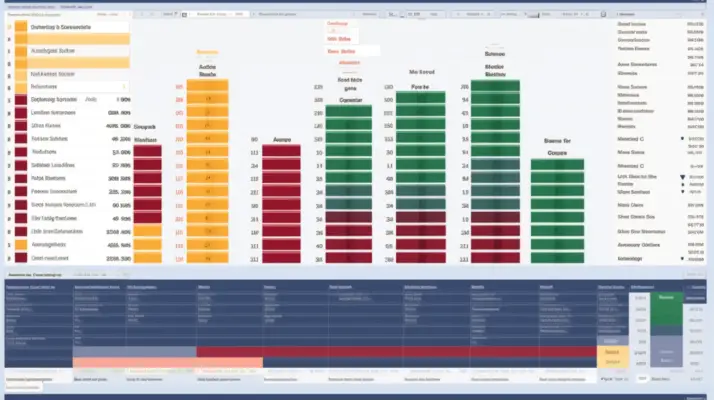The RAMCAP risk assessment methodology has gained significant attention in various industries due to its comprehensive approach to identifying and mitigating potential risks.
This article aims to provide an overview of RAMCAP risk assessment, its applications, and the regulatory framework surrounding its implementation.
Examining the key principles and strategies employed in RAMCAP risk assessment, organizations can enhance their risk management practices and ensure the safety and security of their operations.
Understanding the significance of RAMCAP risk assessment is crucial for aviation, energy, and manufacturing professionals.

Background
RAMCAP Risk Assessment is a systematic approach used in the aviation industry to evaluate and mitigate risks associated with the introduction of new aircraft or modifications to existing aircraft.
It is a proactive process encompassing all aspects of aircraft design, manufacture, and operation to identify potential hazards and assess their likelihood and severity.
The assessment is based on a structured methodology to ensure the safety and reliability of aircraft systems and components.
Definition of RAMCAP Risk Assessment
The definition of RAMCAP Risk Assessment involves a systematic evaluation of potential risks and hazards associated with an aviation system, focusing on key areas such as safety, security, and compliance.
RAMCAP stands for Risk Analysis and Management for Critical Asset Protection, a methodology developed by the Department of Homeland Security.
This approach identifies and assesses vulnerabilities within critical infrastructures, including airports and aviation systems.
By analyzing various scenarios and events, RAMCAP Risk Assessment helps decision-makers make informed choices to mitigate risks and enhance national infrastructure protection.
The current approach to RAMCAP Risk Assessment recognizes that failure to evaluate vulnerabilities adequately can result in significant economic losses and compromise aviation systems’ overall safety and security.
Therefore, it is crucial to conduct thorough assessments to ensure effective risk management and protection of critical assets.
Overview of RAMCAP Risk Assessment
RAMCAP Risk Assessment offers several benefits, including identifying and prioritising potential risks, optimising resource allocation, and enhancing decision-making processes.
The components of RAMCAP Risk Assessment consist of hazard identification, risk analysis, risk evaluation, and risk control.
RAMCAP assesses various risks, such as safety, environmental, economic, and operational risks.
The RAMCAP Risk Assessment process involves data collection, risk analysis, risk evaluation, and the development of risk control measures.
Benefits of RAMCAP Risk Assessment
One advantage of using RAMCAP Risk Assessment is its ability to systematically and comprehensively identify potential risks and hazards systematically and comprehensively.
This risk analysis methodology enables organizations to manage their critical assets and protect them from cyber-attacks effectively.
RAMCAP provides a structured approach to infrastructure protection, aligning with the objectives of the US Department of Homeland Security and the Homeland Infrastructure Threat and Risk Analysis Center, by conducting probabilistic risk assessments.
RAMCAP helps organizations assess the likelihood and consequences of potential hazards, allowing for informed decision-making in risk management.
The National Research Council and the Congressional Research Service have recognized RAMCAP as a valuable tool for evaluating and mitigating risks, making it a trusted method for organizations seeking to enhance their risk management capabilities.
Components of RAMCAP Risk Assessment
An important aspect of RAMCAP is its incorporation of various components contributing to a comprehensive risk assessment process. These components are essential for conducting a thorough and effective analysis of risk management in critical asset protection.
The five key components of RAMCAP risk assessment include:
- Risk Analysis: RAMCAP utilizes a systematic approach to identify, assess, and prioritize risks associated with critical assets. This step involves evaluating potential threats, vulnerabilities, and consequences to determine the likelihood and severity of each risk.
- Resource Application: RAMCAP considers the allocation of resources required for risk management. This component ensures that adequate resources are allocated to mitigate identified risks effectively.
- Reliability Engineering: RAMCAP incorporates engineering principles to assess critical assets’ reliability and maintainability. This approach helps identify potential failure modes and develop strategies to enhance asset performance.
- System Safety: RAMCAP integrates system safety principles to address safety concerns associated with critical assets. This component aims to prevent accidents, injuries, and property damage by implementing appropriate safety measures.
- Interdependent Risks: RAMCAP recognizes the interdependencies between various risks and their potential economic impact. It considers the cascading effects of extreme events to develop a comprehensive risk management strategy.
By incorporating these components, RAMCAP provides a robust risk assessment and management framework for critical asset protection.
Types of Risk Assessed by RAMCAP
RAMCAP, which stands for Risk Analysis and Management for Critical Asset Protection, is a comprehensive framework for critical infrastructure protection.
It aims to identify and mitigate risks to critical assets, such as nuclear power plants and lifeline infrastructure, from man-made and natural disasters.
RAMCAP considers threats like terrorist attacks and natural disasters, ensuring that infrastructure protection practices are robust and effective. By assessing the reliability engineering and system safety of critical assets, RAMCAP contributes to developing and improving current infrastructure protection programs.
This approach is particularly relevant in high-risk areas like Washington, DC, where proactive risk management is paramount.
Process for Conducting a RAMCAP Risk Assessment
To conduct a RAMCAP risk assessment, a systematic and structured process is followed. This process involves the analysis of lifeline infrastructures, specifically the water and wastewater sector, to determine the potential risks and vulnerabilities they face.
The assessment equation used in RAMCAP considers various factors, including the physical assets at risk, the assessment for security requirements, and the approach to disaster impact. Additionally, RAMCAP incorporates the approach to voluntary industry adoption of the NIST cybersecurity framework, ensuring that cybersecurity risks are also considered.
RAMCAP takes a comprehensive approach to evaluating the risks and potential losses that critical assets may face. By identifying and addressing such risks, RAMCAP is a valuable tool for analyzing and managing risks to safeguard lifeline infrastructures.
Applications of RAMCAP Risk Assessment
This will focus on the applications of RAMCAP Risk Assessment in various areas, such as Critical Asset Protection, Cyber Attacks, National Infrastructure Protection Plans, and Lifeline Infrastructures.
RAMCAP Risk Assessment plays a crucial role in identifying and protecting critical assets that are essential for the functioning of an organization or a nation.
It also helps assess and mitigate the risks associated with cyber-attacks, which are increasingly becoming a significant threat in today’s digital age.
RAMCAP Risk Assessment plays a crucial role in the creation and execution of the National Infrastructure Protection Plan. It offers a structured method for identifying weaknesses and securing vital lifeline infrastructures.
Critical Asset Protection
Protecting critical assets is a crucial part of assessing risk. This involves recognizing and securing the assets that are vital for infrastructure systems to function properly.
The Heinz Center emphasizes critical asset protection in its report titled ‘Risk Assessment and Management for Critical Infrastructure Protection.’
The J Standard published by federal agencies guides critical asset protection and risk assessment in process industries.
Additionally, the Clean Water and Drinking Water Infrastructure Sustainability Policy highlights the importance of protecting critical assets in the water sector.
The ASCE Journal of Infrastructure Systems publishes research on resilient infrastructure systems and the analysis for assessment of critical assets.
Cyber assessment risk management is also crucial in protecting critical assets from cyber threats.
Overall, critical asset protection plays a vital role in ensuring the resilience and sustainability of infrastructure systems.
Cyber Attacks
The security and safety of critical assets within infrastructure systems are under constant threat from cyber attacks. As technology advances and systems become more interconnected, the danger of these attacks targeting these assets also rises.
In order to adequately address this risk, it is essential to implement a thorough approach to risk analysis and management. The Department of Energy (DOE) has created guidelines for evaluating and mitigating the risk of cyber attacks in a variety of industries, including power systems as well as the water and wastewater sectors.
These guidelines involve conducting hazard scenarios and employing risk-based decision analysis to identify vulnerabilities and prioritize countermeasure evaluations.
Additionally, resource types and additional information resources are considered to enhance preparedness and response capabilities. Organizations can better protect their critical assets from cyber threats by adopting such risk assessment practices.
National Infrastructure Protection Plan
The National Infrastructure Protection Plan focuses on developing guidelines and strategies to safeguard critical assets within infrastructure systems from potential threats.
One area of focus is risk analysis and management for critical asset protection in the water and wastewater sector. The U.S. Department of Energy and the Department of Homeland Security have collaborated on research and development efforts in this area.
Operations research and decision analysis techniques are applied to assess risks and make informed decisions regarding asset protection. These techniques include risk-based decision analysis with fault tree analyses to evaluate potential losses.
By utilizing these methods, the government can effectively prioritize and allocate resources to protect critical assets in the water and wastewater sector.
Lifeline Infrastructures
The National Infrastructure Protection Plan (NIPP) serves as a framework for identifying and prioritizing the protection of critical infrastructure and key resources. Within the NIPP, lifeline infrastructures, such as the power system, are recognized as essential components that support the functioning of society.
The risk assessment of lifeline infrastructures involves analyzing various reference scenarios, including candidate scenarios that represent potential threats.
This assessment is crucial in making risk-based decisions and prioritizing the allocation of resources for protection and mitigation efforts.
As an illustration, when conducting a risk assessment for power systems, one must take into account the probability and outcomes of incidents like pump or iron pipe malfunctions, as well as deliberate attacks.
By conducting an impartial evaluation of these risks, those in charge can gain a better understanding of the potential repercussions of negative occurrences and implement proactive measures to bolster the durability of essential infrastructures.
Below is a visual representation of the risks involved, a table can be included:
| Scenario | Likelihood | Consequences | Risk Level |
|---|---|---|---|
| Pump failures | High | Moderate | Medium |
| Iron pipe failures | Low | High | Medium |
| Intentional attacks | Low | High | Medium |
This table highlights the potential risks associated with different scenarios, allowing decision-makers to prioritize their efforts accordingly.
Regulatory Framework for RAMCAP Risk Assessment
This discussion will focus on the regulatory framework for RAMCAP Risk Assessment, specifically examining the U.S. Department of Homeland Security Guidelines and the National Research Council Recommendations.
The U.S. Department of Homeland Security Guidelines provide a comprehensive framework for assessing and managing risk in critical infrastructure sectors, including the aviation industry. These guidelines outline the process for conducting risk assessments, identifying vulnerabilities, and implementing appropriate mitigation measures.
On the other hand, the National Research Council Recommendations offer additional guidance on risk assessment methodologies and best practices, drawing on the expertise of leading experts in the field.

U.S. Department of Homeland Security Guidelines
U.S. Department of Homeland Security Guidelines provide a comprehensive framework for assessing risk in the context of ramcap.
These guidelines are designed to assist organizations in identifying potential threats and vulnerabilities and implement appropriate risk mitigation measures.
The guidelines outline a systematic approach to risk assessment, which includes identifying critical assets, evaluating potential threats, assessing vulnerabilities, and determining the potential impact of an attack or incident.
Additionally, the guidelines emphasize the importance of conducting regular risk assessments to ensure the ongoing effectiveness of risk management strategies.
Organizations can improve their understanding of the risks linked with ramcap by adhering to these guidelines and devising effective strategies to mitigate them.
This analytical and well-researched approach facilitates a more proactive and comprehensive risk management process for organizations involved in ramcap risk assessment.
National Research Council Recommendations
National Research Council recommendations offer valuable insights into effectively managing the potential threats and vulnerabilities associated with ramcap risk assessment. These recommendations provide a comprehensive framework for understanding and addressing the risks posed by ramcap.
Key points include:
- Enhanced collaboration between government agencies and private sector stakeholders to share information and resources.
- Development of robust risk assessment methodologies to identify and prioritize potential threats.
- Regular and thorough testing and evaluation of ramcap systems to ensure their effectiveness.
- Implement proactive measures to mitigate risks, such as regular software updates and system maintenance.
- Continuous monitoring and analysis of emerging threats and vulnerabilities to stay ahead of potential risks.
Frequently Asked Questions
How does RAMCAP risk assessment compare to other risk assessment methodologies?
Ramcap risk assessment can be compared to other methodologies based on its effectiveness, accuracy, and comprehensiveness in evaluating potential risks.
Comparisons should consider factors such as scope, applicability, and the level of detail provided in the analysis.
Are there any limitations or challenges associated with implementing RAMCAP risk assessment?
Limitations and challenges associated with implementing risk assessment methodologies include lack of data availability, subjectivity in risk scoring, and difficulty quantifying risks.
These issues may also apply to the implementation of RAMCAP risk assessment.
What are the key factors that are considered in RAMCAP risk assessment?
Key factors considered in risk assessment include the identification and analysis of hazards, evaluation of potential consequences, determination of likelihood, assessment of risk levels, and development of risk management strategies.
Can RAMCAP risk assessment be applied to different industries, or is it specific to a certain sector?
The applicability of ramcap risk assessment may vary across industries. Although it is created to evaluate risks across various fields, the factors taken into account should be customized according to the distinct attributes and needs of each industry.
Is there any specific training or certification required to conduct RAMCAP risk assessment?
Specific training or certification is not required to conduct a RAMCAP risk assessment. People who have experience in risk management or engineering are likely to have the required expertise to conduct assessments in different fields.

Conclusion
The RAMCAP risk assessment is a valuable tool for evaluating potential risks in various industries. It provides an overview of the risk management process, including hazard identification, risk analysis, and risk control measures.
This assessment can be applied in several sectors, such as aviation, pharmaceuticals, and manufacturing, to ensure safety and compliance with regulations. The regulatory framework for RAMCAP risk assessment ensures that organizations follow standardized protocols and guidelines.
Overall, RAMCAP risk assessment is crucial in mitigating risks and promoting a safer working environment.

Chris Ekai is a Risk Management expert with over 10 years of experience in the field. He has a Master’s(MSc) degree in Risk Management from University of Portsmouth and is a CPA and Finance professional. He currently works as a Content Manager at Risk Publishing, writing about Enterprise Risk Management, Business Continuity Management and Project Management.

